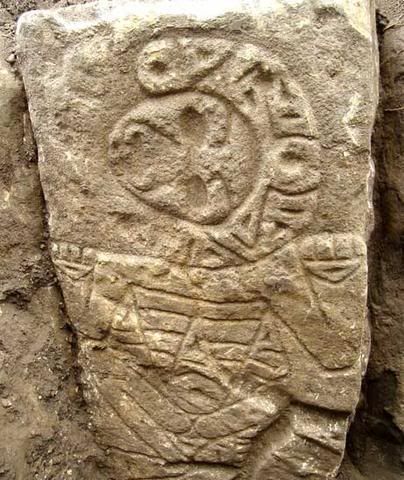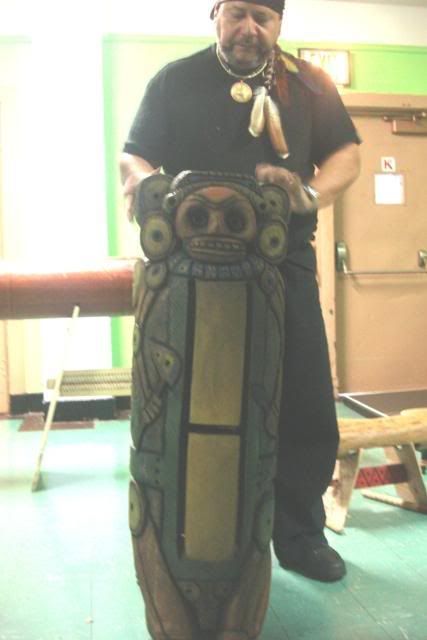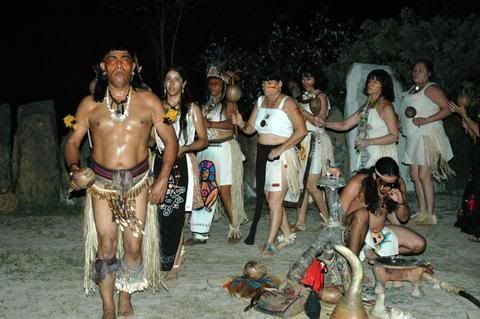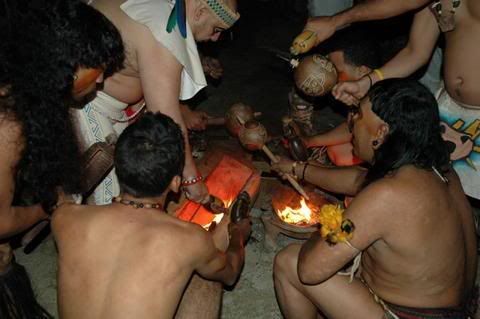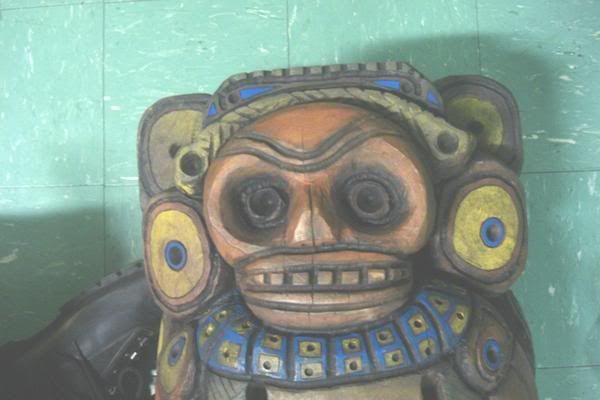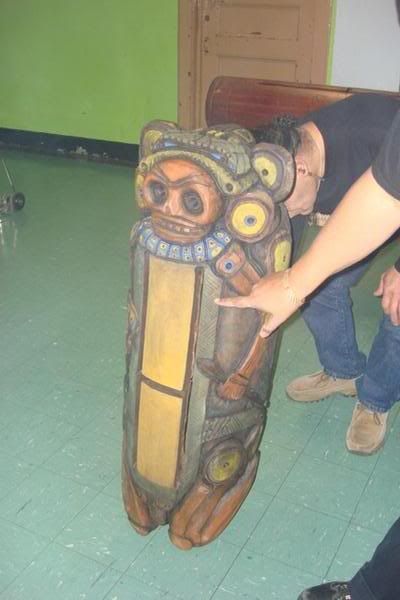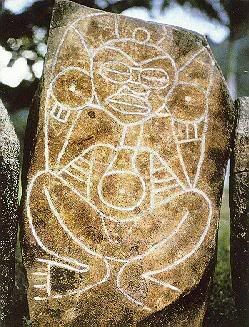 OSVALDO GARCIA GOYCO
OSVALDO GARCIA GOYCO 1984
translation by tainoray
Investigations on the subject
1. The sculpturing in stone of the idols whose symbols of identity corresponde to parallel deities of the pantheon of the civilizations of the central and mesoamericans
2. The concept of duality, grandmother, creator and creative grandfathers old God, associated with certain signs of the cosmological stories of the origin of the universe in the sexual act and with the providence of the man and the grotto Gods or caverns
3.The concept of the one God in form of Quadruple represented by the four mitological heroes
4. the divine concept of the God of the fire associated to quincunce, binoculars. the treatment of the disease delas bubas, with guayacan and center the one of a falic cult
5. the myth of the deluge, associated to mitologies of the the four adventures of heroes like in the popol vuh
6.The equivalence of Hurakan, Gucumatz and Quetzalcoatl Tezcatlipoca
7. The symbolism of the God of the wind that presents/displays common elements of the Ehecatl, bird tip, with the snail and quincunce, also of the fire God
8. the concept of a God of Rain, associated to the mountains and the four tlacocs or pools where the waters are recojen. Its association with the frog, rain and sequia
9.The God of the fire associated with the symbol of the solar cycle, with the falic cult, the offerings of blood, very problemente, with the iguana or terreste lizard, solar food of the Gods and the main senores
10.The concept of a God of the death identified by its equivalent symbolism with the Mayan Ahpuch and the Mictlantecuhhtli of and Mexican respectively. Its identification with the "senor of place of the dead"
11. the probable association of the suicide of the hanged people and paradise, that a clear derivation suggests in the Antilles
12. The ball game probable significaton of religious rites and probable association also with the human sacrifice of victims that was buried, like between the Mayans, in their own ceremonial seat
13. Sacrifices by bloody hands & feet that points at a major derivative
14. the presence of birds that identify animals with asociacones to the solar cult: colibri, aguila (guaraguao), turkey (or guanaho) and buho (or mucaro) in representation all of them as the sun
15. the use of the solar disc as different from the Gods in the Mexican codices and of Antillean Cacikes and Central Americans
16. the possible association of socio-political organization with the religious ideas to traves of the tribal division in halves and perhaps fratias. this I complete in the Antilles and powerfully suggests the morphemic analysis of the names of the Cacikes
17.the theft of the Gods or idols by cacikes in the yucatan and the antilles
18. the association of the protective serpent of indigenous medicine and Beike (shaman) that practices it
19.the ritual presence of tlacaxipehuallitli (sacrifice by flechamiento) in Puerto Rico with probable connatations of fecundity
20. the connection that exists between the Earth deities, of the night and of the dead.
21. the Goddess of the moon associated with the diseases, the floods, and the childbirths
22. the craneal deformation and the cult of the solar corn God
23. the pectoral one of the wind of the God Guatauba formed by the cross section of a marine snail (caracol)
Like subject common between iconography and the art of the Indian Antilleans and the mesoamericanos, we create to have been able to identify the following ones.
1, Geometric reasons like the lambda-type bands for t's invested stepped and quincunce.
2, Bas-relief of figure that allude to the position of the frog
3, Monolithic belts associated to the night, the death, and the ball game (Batu).
4, Images with four depressions felacionadas with rain
5, Faces the language outside
6, Faces with beards
7, Figures of dancers without arms nor torso and with the open legs
8, Figures of frogs representandas by a rhomboid with I circulate in folded means and payas
9, Sigmoides of two and four vanes related to the movement of the Hurricane.
10, Figures surrounded in drawn into squares around the body with crests in the head
1i. the representation of glyph Mayan Ahau associated with the Gods of the dead
12, Images of the God of the dead represented by an emaciated face
13, Representations of the God of rain with three tears in the eyes and to accustom eyeglasses.
14, Figures with two heads
15, Symbol of the mesoamericano solar represented by I circulate with three triangles raisesd
16, Imagenes with a tortoise shell in the back associated the four binoculars
17, Imagenes with a snail in the back (caracol)
18, Representations of 4 binoculars
19, Round faces with crests and spirals around, similar to the glyph Ahau
20. The representation of the sun as I circulate around divided in two with 6 crests (Sol de Jayuya petroglyph), similar to the Aztec Yohuailli ( Sol de la Noche)
21, Reliefs of the sun as a face with rays in form of petals around all the circumference
(Sol de Utuado) Puerto Rico Mayan Glyph in Chiche Nitza
22. The representation of the Mother goddess even with spiral sines and the hands in top (Caguana Petroglyph)
23, Hemaphrodited Images with breast and penis that represent the fundamental pair
24, Images of the old God of the fire in its position characteristic, squatting and the hands in it knees or the chin
25, Images of the old God of the fire with a platform on the head
26, Images of serpents with solar symbols divided by rays in body
As a final commentary of the present work, we can affirm very categorically that we have been able to compare this comparative study that there exists a common mitological trunk between the Indigenous Mesoamericana area & The Greater Antilles.
The mitological structure present in both cultural areas, the simililarity of the names of the deities and its representations, but the concept of the ball game and its ceremonial aspect are too similar so that this can be explained like characteristics of an independent parallel development or archetypes of an unconscious group.
It is of vital importance of stressing that the name of the Mesoamerican Gods that agree with the Antilleans is NOT found between the Arawak Tribes and Caribs of Venezuela. This aims clearly at the fact that the Mesoamerican influence directly passes to the Antilles through via maritime and not of South America, because to have been the cultural contact to traves of Venezuela the names of the Mesoamerican Gods had not been conserved there also, that do not happen. The same it happens with the structures in stone of the ball game, present in Mesoamerica & the Antilles but ABSENT in South America.
Although concepts of the independent invention has been put very fashionable in the last decade, the idea of cultural transmission from a town to another one is the logical explanation of the extraordinary similarity that to us some cultures present/display. On this Nanda 1982:49 says that "many antropologist are in agreement in which a genuine single explains independent invention a small percentage of the cultural exchange".
The Antropological work of A.L. Kroeber 1945:251 "this it says when speaking of the limitations of parallelism or independent invention like cultural process the following thing:"Of the tests reviewed in this I capitulate and in the previous one it is confirmed that no single there are over one hundred examples of historical diffusion, by one of parallelism, but that this I complete, by regulating of is limited reach. Something tends to make see but fenomenos parallels us of which really they exist"
TO THIS HE ADDS
"The process MOST frequent in the history of the culture is the one of the transmission or the diffusion in the time and the space "
.AND IT CONCLUDES"
a substantial identity, a correspondence of part by part, is invariably a sign of a COMMON ORIGIN".
It is indeed that substantial identity, that correspondence of part by part, in Mesoamericana and Taina, which we have left demonstrated widely in this work.
OSVALDO GARCIA GOYCO 1984







